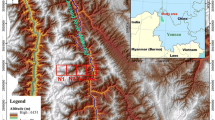Abstract
Vegetation and environment have been analyzed along an altitudinal gradient in Harena Forest, Bale Mountains National Park, southeastern Ethiopia. Vegetation data include numbers of each tree and shrub species and cover-abundance values of each herbaceous species. Environmental data comprise edaphic factors, altitude and topography. The two vegetation layers data were analysed separately.
Probabilistic similarity coefficients were computed between the relevés, and these values were used in subsequent computations for classification and ordination. Two sets of stratocoena, comprising 6 types each, derived on the basis of separate analyses of tree-shrub and herb layers of the forest were recognised. A combination of the two sets of stratocoena produced a total of 11 vegetation types. Environmental fuzzy set analysis was applied to determine the strength of the relationship of the relevés to the environmental factors. Autocorrelation analysis was applied to the eigenvectors of probabilistic similarity matrices and environmental data. Altitude appears to be more important than the other environmental factors in controlling the zonation of the forest. Other important environmental influences on the vegetation include pH, organic matter content and texture of the soil. It is suggested that the whole forest be included in the National Park to create suitable conditions for adequate protection.
Nomenclature
follows Cufodontis, G. 1953–1972. Enumerado Plantarum Ethiopiae. Bull. Jard. Bot. Belg., and Hedberg, I. & Edwards, S. (in press). Flora of Ethiopia. Vol. III. Addis Ababa University, Addis Ababa.
Access this chapter
Tax calculation will be finalised at checkout
Purchases are for personal use only
Preview
Unable to display preview. Download preview PDF.
Similar content being viewed by others
Abbreviations
- EFS:
-
Environmental fuzzy sets
- PROSIM:
-
Probability similarity index
- PCA:
-
Principal components analysis
References
Barkman, J. J. 1978. Synusial approaches to classification. In: Whittaker, R. H. (ed.), Classification of plant communities, pp. 113–165. Dr. W. Junk, The Hague.
Braun-Blanquet, J. 1964. Pflanzensoziologie. Grundzüge der Vegetationskunde. 3. Aufl. Springer-Verlag, Wien.
Daniel Gamachu 1977. Aspects of climate and water budget in Ethiopia. Addis Ababa Univ. Press, Addis Ababa.
Feoli, E. 1977. On the resolving power of principal components analysis in plant community ordination. Vegetatio 33: 119–125.
Feoli, E. & Ganis, P. 1986. Autocorrelation for measuring predictivity in community ecology: An example with structural and chorological data from mixed forest in NE Italy. Coenoses 1: 53–56.
Feoli, E., Lagonegro, M. & Orlóci, L. 1984. Information analysis of vegetation data. Dr. W. Junk, The Hague.
Feoli, E. & Zuccarello, V. 1986. Ordination based on classification: Yet another solution? Abstr. Bot. (Budapest) 10: 203–219.
Friis, I. (in press). Zonation of the vegetation on the south slope of the Bale Mountains. Proc. Sect. Int. Symp. Flora Ethiopia.
Gabriel, K. R. 1971. The biplot graphic display of matrices with application to principal components analysis. Biometrika 58: 453–467.
Ganis, P. 1985. Spatial autocorrelation analysis, a computer program and examples of application with different data from grassland vegetation under natural reforestation process in the karst near Trieste. Stud. Geobot. 5: 127–142.
Goodall, D. W. 1964. A probabilistic similarity index. Nature 203: 1098.
Goodall, D. W. 1966. A new similarity index based on probability. Biometrics 22: 883–907.
Goodall, D. W. 1968. Affinity between an individual and a cluster in numerical taxonomy. Biometr. Praximetr. 9: 52–55.
Goodall, D. W. & Feoli, E. 1988. Application of probabilistic methods in the analysis of phytosociological data. Coenoses 3: 1–10.
Goodall, D. W., Ganis, P. & Feoli, E. 1987. Probabilistic methods in classification: A manual for seven computer programs. Gruppo Elabor. Automat. Dati — Ecol. Quant., Trieste 7: 1–50.
Jou, A. S. R. (ed.) 1978. Selected methods of soil analysis. Int. Inst. Trop. Agricult., Ibadan, Nigeria.
Lagonegro, M. & Feoli, E. 1984. THREE-Package for classification and ordination of multivariate data. Libreria Goliardica, Trieste.
Lagonegro, M. & Feoli, E. 1985. The use of ellipses of equal concentration to analyse ordination vegetation patterns. Stud. Geobot. 5: 143–165.
Mueller-Dombois, D. & Ellenberg, H. 1974. Aims and methods of vegetation ecology. J. Wiley & Sons, N.Y.
Murphy, H. P. 1958. The fertility status of some soils in Ethiopia. College of Agriculture, Jimma, Ethiopia.
Orlóci, L. 1978. Multivariate analysis in vegetation research. 2nd ed. Dr. W. Junk, The Hague.
Roberts, D. W. 1986. Ordination on basis of fuzzy set theory. Vegetatio 66: 123–131.
ter Braak, C. J. F. 1983. Principal components biplots and alpha and beta diversity. Ecology 64: 454–462.
van der Maarel, E. 1979. Transformation of cover-abundance values in phytosociology and its effects on community similarity. Vegetatio 39: 97–114.
Walter, H. & Lieth, H. 1960. Klimadiagramm-Weltatlas. Gustav Fischer, Stuttgart.
Westhoff, V. & van der Maarel, E. 1978. The Braun-Blanquet approach. In: Whittaker, R. H. (ed.), Classification of vegetation, pp. 617–726. Dr. W. Junk, The Hague.
Weinert, E. & Masurek, A. 1984. Notes on the vegetation and soils of Bale province of Ethiopia. Feddes. Repert. 95: 373–380.
Wildi, O. & Orlóci, L. 1983. Management and multivariate analysis of vegetation data. 2nd ed. Eidgenössische Anstalt für das forstliche Versuchswesen, Birmensdorf (ZH), Switzerland.
Zimmerman, H. J. 1986. Fuzzy sets. The theory and its application. Kluwer, Boston.
Author information
Authors and Affiliations
Editor information
Rights and permissions
Copyright information
© 1989 Kluwer Academic Publishers
About this chapter
Cite this chapter
Woldu, Z., Feoli, E., Nigatu, L. (1989). Partitioning an elevation gradient of vegetation from southeastern Ethiopia by probabilistic methods. In: Mucina, L., Dale, M.B. (eds) Numerical syntaxonomy. Advances in vegetation science, vol 10. Springer, Dordrecht. https://doi.org/10.1007/978-94-009-2432-1_16
Download citation
DOI: https://doi.org/10.1007/978-94-009-2432-1_16
Publisher Name: Springer, Dordrecht
Print ISBN: 978-94-010-7597-8
Online ISBN: 978-94-009-2432-1
eBook Packages: Springer Book Archive




